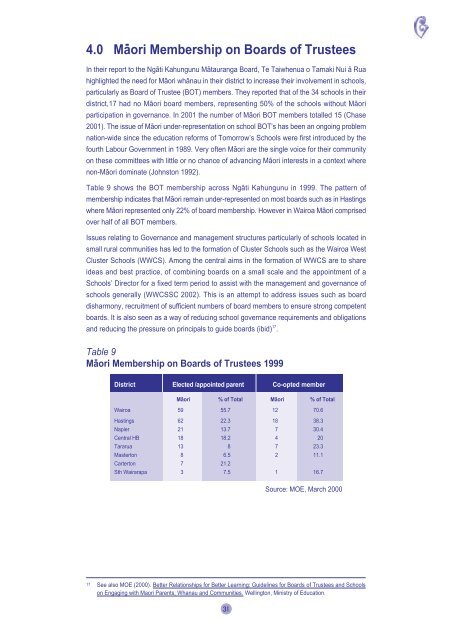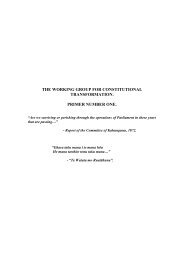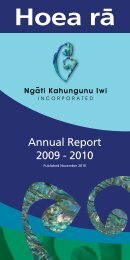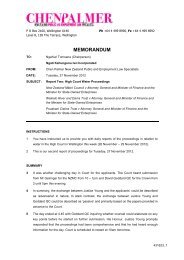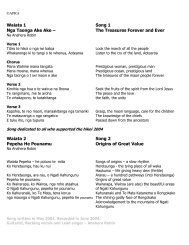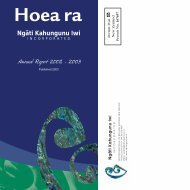Matauranga Strategy - NgÄti Kahungunu Iwi Incorporated
Matauranga Strategy - NgÄti Kahungunu Iwi Incorporated
Matauranga Strategy - NgÄti Kahungunu Iwi Incorporated
You also want an ePaper? Increase the reach of your titles
YUMPU automatically turns print PDFs into web optimized ePapers that Google loves.
4.0 Mäori Membership on Boards of Trustees<br />
In their report to the Ngäti <strong>Kahungunu</strong> Mätauranga Board, Te Taiwhenua o Tamaki Nui ä Rua<br />
highlighted the need for Mäori whänau in their district to increase their involvement in schools,<br />
particularly as Board of Trustee (BOT) members. They reported that of the 34 schools in their<br />
district,17 had no Mäori board members, representing 50% of the schools without Mäori<br />
participation in governance. In 2001 the number of Mäori BOT members totalled 15 (Chase<br />
2001). The issue of Mäori under-representation on school BOT’s has been an ongoing problem<br />
nation-wide since the education reforms of Tomorrow’s Schools were first introduced by the<br />
fourth Labour Government in 1989. Very often Mäori are the single voice for their community<br />
on these committees with little or no chance of advancing Mäori interests in a context where<br />
non-Mäori dominate (Johnston 1992).<br />
Table 9 shows the BOT membership across Ngäti <strong>Kahungunu</strong> in 1999. The pattern of<br />
membership indicates that Mäori remain under-represented on most boards such as in Hastings<br />
where Mäori represented only 22% of board membership. However in Wairoa Mäori comprised<br />
over half of all BOT members.<br />
Issues relating to Governance and management structures particularly of schools located in<br />
small rural communities has led to the formation of Cluster Schools such as the Wairoa West<br />
Cluster Schools (WWCS). Among the central aims in the formation of WWCS are to share<br />
ideas and best practice, of combining boards on a small scale and the appointment of a<br />
Schools’ Director for a fixed term period to assist with the management and governance of<br />
schools generally (WWCSSC 2002). This is an attempt to address issues such as board<br />
disharmony, recruitment of sufficient numbers of board members to ensure strong competent<br />
boards. It is also seen as a way of reducing school governance requirements and obligations<br />
and reducing the pressure on principals to guide boards (ibid) 17 .<br />
Table 9<br />
Mäori Membership on Boards of Trustees 1999<br />
District<br />
Elected /appointed parent<br />
Co-opted member<br />
Mäori % of Total Mäori % of Total<br />
Wairoa 59 55.7 12 70.6<br />
Hastings 62 22.3 18 38.3<br />
Napier 21 13.7 7 30.4<br />
Central HB 18 18.2 4 20<br />
Tararua 13 8 7 23.3<br />
Masterton 8 6.5 2 11.1<br />
Carterton 7 21.2<br />
Sth Wairarapa 3 7.5 1 16.7<br />
Source: MOE, March 2000<br />
17 See also MOE (2000). Better Relationships for Better Learning: Guidelines for Boards of Trustees and Schools<br />
on Engaging with Maori Parents, Whanau and Communities. Wellington, Ministry of Education.<br />
31


